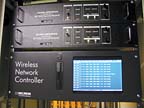

Part of CMFP’s business is installing and maintaining radio transmission systems around Chicago. An installation in Naperville, Ill., has proven to be a win-win-win for CMFP, the city and its commercial fire alarm customers.
In 2002, the dealership won a five-year contract with Naperville to install and maintain its radio transmission fire alarm system. When service is needed, CMFP is dispatched to provide it.
“We maintain the network and head-end equipment in Naperville and get a dollar figure per month,†reports Larry Coveny, sales manager for CMFP.
CMFP sometimes can offer next-day radio installation instead of the six to eight weeks required to get a phone line. The company also installs spare radios for the city when a customer has a problem with one. The cost of service is built into the customer’s lease on its radio – no service charge is made.
The system installed in Naperville in 2002 broadcasts on fixed UHF frequencies 455-470 MHz and is FCC narrow-band compliant. These frequencies are set aside exclusively for local fire alarm notification. It uses radios and software from AES IntelliNet, Peabody, Mass., and active network equipment from Keltron Corp., Waltham, Mass.
Each radio also is a repeater – it receives signals and transmits them to the next radio from 2.5 to 6 miles away depending on the geography around it, Coveny explains, so no transmitting towers are needed.
“Naperville is approximately 29 square miles, so what we did initially to get the network was set up the radios in eight fire departments and two municipal locations,†Coveny explains. “Only three or four radios set up a network in some systems depending on an area’s geography.â€
The radios have 24-hour battery backup if power is lost and are polled by the system every minute to see if they have power. At each location, the radios are hardwired into the fire alarm power and are part of the same circuit that cannot be shut off or interrupted.
Any power losses by radios are reported automatically to the system as well as when power is restored.
The advantage that CMFP sells municipalities on is that the municipality receives all the money from customers for monitoring that used to go to a monitoring company. Many municipalities lease the equipment, but Naperville is purchasing it at the end of a five-year lease.
Before installing its own fire alarm radio transmission system, Naperville received from central station monitoring companies only $5 monthly per customer for monitoring fire alarms. “That was not even close to what it actually cost us,†insists Dan Voiland, project manager for the communications upgrade project for Naperville.
“We are taking in close to $600,000 a year right now and paying out about $480,000 to lease the equipment and maintain it,†he explains. “We’re doing everything we did before, we’re just doing the invoicing, too.â€
The third advantage is for customers, whom Voiland thinks generally are paying less than they did for monitoring through phone lines. Most pay $49.85 monthly for use of the radio equipment and monitoring rather than the $60 to $75 he estimates they were paying monthly before.
Because 90 percent of Naperville’s 1,500 customers pay their monitoring fees in advance annually, invoicing is not a major expense. “We send them an annual invoice and return envelope and track when they pay it and that’s pretty much it,†Voiland notes.
Those customers who wish to pay more frequently use the annual invoice to set up an automatic recurring monthly or quarterly payment system.
“That helps us to keep our costs lower,†Voiland explains. “We have held our pricing firm since the day we started this. Unless something major happens, we pretty much said we would leave our prices firm for a five-year period, and we’ve been able to do that three years into the program.
“Our inventory is over $1 million,†Voiland stresses. “We do not actually let the customer buy the radio.†This is for security reasons so customers will not move them and so the radio can remain in the building even when its occupancy changes.
Voiland insists the city has gotten involved in the fire alarm business for public safety reasons. “For our customers, fire alarms generally are dispatched within 30 seconds of receipt,†he maintains. “It can take a couple of minutes if it comes from a central station. In a fire, a couple of minutes in a delayed dispatch process can do millions of dollars worth of damage.â€
Participation in the program is voluntary and customers are free to choose other service providers besides CMFP when their systems need repair.
“We have a 60-day out-clause if you’re really upset with the city,†Voiland notes. “I don’t think we have had anyone leave. We’ve picked up 500 more customers than when we started three years ago.â€
Approximately 3,000 commercial accounts that include multiunit residential buildings are in Naperville. The half of those accounts the city is not monitoring use private central stations. Approximately 200 are still monitored through phone lines by the city, Voiland estimates.
Some customers have not switched over because they are in long-term contracts with their current security dealers. Others tell Voiland they are paying a rate lower than the city’s for conventional monitoring by phone lines.
False alarms have decreased 20 percent during operation of the radio system, Voiland calculates. “A lot of it is the elimination of the phone lines,†he maintains. “Only one or two radios in three years have we had a problem with.
“If the phone company because of the rapid growth in Naperville does a lot of switching and moving lines around, they can bump circuits, cut things off and cause false alarms,†Voiland explains. “The other cause is just thunderstorms because a phone line is susceptible to be hit by lightning.
“In some of the bigger thunderstorms, it was not unusual to get 100 false alarm calls,†he notes. “This last year, we had 60.†He estimates savings of $30,000 annually in responding to false alarms. His goal is to decrease false alarms by 40 percent.
The Naperville 911 center’s equipment is UL-listed and the center meets all guidelines of the National Fire Protection Association (NFPA). â€If you were to compare us to a central station, we’d have all the same in terms of backup power, generator, UPS power, all those types of systems are in place,†Voiland emphasizes.
Several other communities in the Chicago area are offering or considering offering similar systems to transmit fire alarm signals by radio. Communities in New England states, New York and California are considering or using them, according to information from Keltron Corp.
“We have a difference of opinion,†concedes Tony Calderone, president of the Illinois Electronoic Security Association (IESA). “We certainly promote professional central station monitoring.
“We think that the alarm industry is best equipped to handle the myriad of different types of signals that can be generated from protected premises,†Calderone insists. “Radio monitoring limits the number of signals that can be sent. The fire department doesn’t know what may be happening until its trucks arrive on the scene.
“That’s where we think independent central station monitoring has an edge,†he emphasizes. “But at the same time, we do recognize the authority of local municipalities to require direct connection to municipal headquarters.â€
Calderone points out that some municipalities only lease their radio transmission equipment from a security company.
“Naperville is a large enough city so that on the economic side, there’s enough subscribers that can represent a substantial cash flow to the municipality,†he notes. “For a lot of smaller communities, the dollar amount they may receive from only 100 subscribers is inconsequential.â€
Nevertheless, the numbers add up in Naperville.




